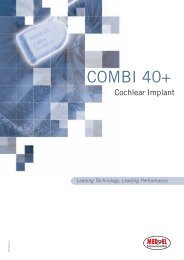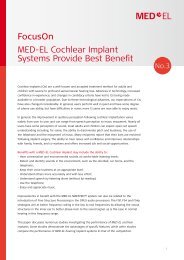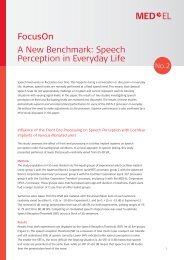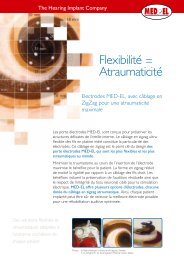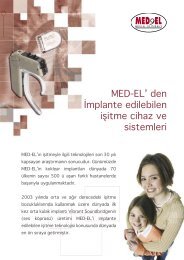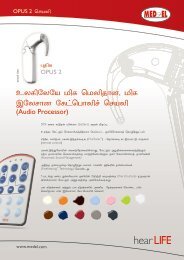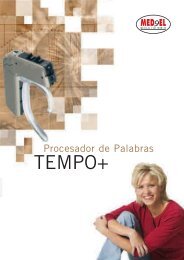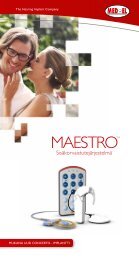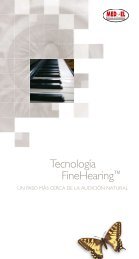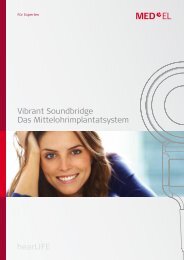thin and flexible free-fitting electrodes demonstrated to best ... - Med-El
thin and flexible free-fitting electrodes demonstrated to best ... - Med-El
thin and flexible free-fitting electrodes demonstrated to best ... - Med-El
Create successful ePaper yourself
Turn your PDF publications into a flip-book with our unique Google optimized e-Paper software.
For Professionals<br />
MED-EL <strong>El</strong>ectrode Arrays<br />
Designed for Atraumatic Implantation<br />
Providing Superior Hearing Performance
World’s Largest Selection of <strong>El</strong>ectrodes<br />
for a Variety of Cochlear Duct Lengths (CDLs) 1,3<br />
Cochleae may differ significantly in size <strong>and</strong> shape<br />
from one another as can individual cochlear duct<br />
lengths. MED-EL offers the largest selection of<br />
electrode arrays. Each implant recipient can be<br />
sure <strong>to</strong> receive the <strong>best</strong> possible electrode array<br />
for their unique cochlear ana<strong>to</strong>my.<br />
Complete Cochlear Coverage (CCC) 2, 5<br />
Complete Cochlear Coverage means stimulating the<br />
cochlea from the base <strong>to</strong> the apical region in order<br />
<strong>to</strong> stimulate a maximum number of nerve fibres.<br />
Stimulation of the entire frequency range with a<br />
deeply inserted, long array provides the implant user<br />
with the <strong>best</strong> possible outcomes in speech<br />
performance measures <strong>and</strong> in sound quality.<br />
Audi<strong>to</strong>ry Brainstem Implant (ABI)<br />
Distribution of CDL<br />
0.2<br />
0.15<br />
0.1<br />
0.05<br />
0<br />
-0.05<br />
Designed Especially for Neurofibroma<strong>to</strong>sis Type II<br />
ABI is a solution for individuals with hearing loss due<br />
<strong>to</strong> a non-functioning audi<strong>to</strong>ry nerve (Neurofibroma<strong>to</strong>sis<br />
Type II). Bypassing both the inner ear <strong>and</strong> the audi<strong>to</strong>ry<br />
nerve, the MED-EL ABI stimulates the cochlear nucleus<br />
(CN) <strong>and</strong> provides users with a variety of hearing<br />
sensations <strong>to</strong> assist with sound awareness <strong>and</strong><br />
communication.<br />
-0.1<br />
N=95<br />
MIN MAX<br />
25 26 27 28 29 30 31 32 33 34 35 36<br />
CDL (mm)<br />
Bell curve of the distribution of cochlear duct lengths.<br />
“... <strong>thin</strong> <strong>and</strong> <strong>flexible</strong> <strong>free</strong>-<strong>fitting</strong> <strong>electrodes</strong> <strong>demonstrated</strong><br />
<strong>to</strong> <strong>best</strong> fulfill all criteria for atraumatic CI surgery.” 8<br />
ABI <strong>El</strong>ectrode Array<br />
Featuring 12 contacts arranged on a soft,<br />
pre-shaped silicone paddle.
MED-EL <strong>El</strong>ectrode Arrays<br />
Designed for Atraumatic Implantation<br />
Providing Superior Hearing Performance 4,6,7<br />
MED-EL is the leader in providing soft, <strong>flexible</strong><br />
electrode arrays which ensure maximum protection<br />
of the delicate structures in the cochlea. Preserving<br />
residual hearing enables users <strong>to</strong> benefit from future<br />
technologies <strong>and</strong> therapies.<br />
Wave-Shaped Wires<br />
The electrode arrays feature ultra<strong>flexible</strong> wave-shaped<br />
platinum-iridium wires. This wire design is the key <strong>to</strong><br />
making a MED-EL electrode array the world’s most<br />
<strong>flexible</strong> <strong>and</strong> atraumatic. Minimising trauma during<br />
electrode insertion maximises the benefit <strong>to</strong> the<br />
patient. Wave-shaped wires significantly reduce rigidity<br />
in comparison <strong>to</strong> a straight-wire design. Benefits<br />
include preserving the integrity of intraneural tissue<br />
targeted for electrical stimulation.<br />
FLEX TIP TECHNOLOGY<br />
The FLEx tip of the electrode<br />
array is designed for<br />
atraumatic insertion <strong>and</strong><br />
protection of the delicate<br />
neural structures of the<br />
cochlea.<br />
Optimal Number of Contacts<br />
MED-EL’s electrode design philosophy dictates a careful<br />
balance between the maximum number of electrode<br />
contacts <strong>and</strong> minimised channel interaction. Channel<br />
interaction negatively impacts performance. Each<br />
electrode array contains the optimal number of<br />
contacts for stimulation of nerve fibres leading <strong>to</strong><br />
<strong>best</strong> performance. Optimal number <strong>and</strong> spacing of<br />
electrode contacts also significantly reduces rigidity;<br />
allowing for gentle insertion without damaging the<br />
delicate cochlear structures.<br />
FLEX Tip Technology<br />
The unique FLEx tip features single electrode contacts<br />
on the leading end <strong>to</strong> further increase mechanical<br />
flexibility. Softness <strong>and</strong> flexibility allow insertion in<strong>to</strong><br />
the apical region.<br />
WAVE-SHAPED WIRES<br />
Wavy instead of straight,<br />
the wires of the electrode<br />
array are particularly soft<br />
<strong>and</strong> <strong>flexible</strong>.<br />
OPTIMAL NUMBER<br />
OF CONTACTS<br />
Achieving optimal balance<br />
between the number of<br />
contacts <strong>and</strong> the appropriate<br />
distance between them<br />
increases flexibility <strong>and</strong> limits<br />
channel interactions.
FLEx SOFT<br />
A 31mm electrode array<br />
featuring FLEx tip technology<br />
for increased mechanical<br />
flexibility <strong>and</strong> enabling CCC.<br />
FLEx 28<br />
A 28mm electrode array suitable<br />
for 96% of all normal cochlear<br />
duct lengths featuring FLEx tip<br />
technology. Optimised for<br />
insertion in<strong>to</strong> the apical<br />
region (CCC).<br />
FLEx 24<br />
A 24mm electrode array featuring<br />
FLEx tip technology <strong>and</strong> designed<br />
for combined <strong>El</strong>ectric Acoustic<br />
Stimulation (EAS) with insertion<br />
less than 1.5 turns.<br />
FLEx 24 is formerly known as the FLEx EAS .<br />
FLEx 20<br />
NEW<br />
A 20mm electrode array featuring<br />
FLEx tip technology <strong>and</strong> designed <strong>to</strong><br />
be used in cases of partial deafness<br />
or for other specific needs or<br />
surgical preferences.<br />
The FLEx 20 is under development.<br />
1<br />
Active Stimulation Range: 26.4mm<br />
Ø 1.3mm<br />
3<br />
Ø 0.4mm<br />
2<br />
FLEX tip<br />
31.5mm<br />
1<br />
Active Stimulation Range: 26.4mm<br />
19 platinum electrode contacts<br />
Optimal spacing over a 26.4mm stimulation range<br />
Ø 1.3mm<br />
3<br />
Ø 0.8mm<br />
2 FLEx tip for minimal Active insertion Stimulation trauma Range: 23.1mm<br />
Ø 0.4mmDiameter<br />
1 at apical end: 0.5 x 0.4mm<br />
3<br />
23<br />
Diameter at basal end: 1.3mm<br />
FLEX tip<br />
Ø 0.4mm<br />
31.5mm<br />
1<br />
2<br />
FLEX Active tip Stimulation Range:<br />
28mm<br />
26.4mm<br />
Ø 1.3mm<br />
3<br />
Ø 0.8mm<br />
Ø 0.4mm 1<br />
2<br />
FLEX tip<br />
Ø 0.4mm<br />
Active Stimulation Range: 23.1mm<br />
Active Stimulation Range: 20.9mm<br />
1<br />
31.5mm<br />
3<br />
Ø 0.8mm<br />
3<br />
2<br />
FLEX<br />
Ø 0.3mm Active<br />
tip<br />
Stimulation Range: 28mm 26.4mm<br />
1<br />
2<br />
Active FLEX Stimulation tip Range:<br />
1 19 platinum electrode contacts 24mm<br />
23.1mm<br />
Ø 0.4mm 1<br />
Optimal spacing over a 23.1mm stimulation range<br />
2<br />
2 FLEx tip for minimal Active insertion Stimulation trauma Range: 20.9mm<br />
FLEX tip<br />
Ø 0.4mm 1<br />
Diameter at apical end: 31.5mm 0.5 x 0.4mm<br />
2<br />
3 Diameter FLEX tipat<br />
basal end: Active 0.8mmStimulation<br />
Range: 16.5mm<br />
Ø 0.3mm 1 28mm<br />
Ø 1.3mm<br />
3<br />
Ø 0.8mm<br />
3<br />
Ø 0.8mm<br />
3<br />
Ø 0.8mm<br />
3<br />
1<br />
Ø 0.4mm<br />
2<br />
Active<br />
FLEX<br />
Ø Stimulation<br />
tip<br />
0.3mm Range: 24mm23.1mm<br />
2<br />
Active<br />
FLEX<br />
Stimulation<br />
tip<br />
Range: 20mm 20.9mm<br />
1<br />
Ø 0.8mm<br />
3<br />
Ø 0.8mm<br />
3<br />
Ø 0.8mm<br />
2<br />
FLEX tip<br />
Ø 0.3mm 1<br />
Active Stimulation Range: 16.5mm<br />
28mm<br />
3<br />
2<br />
FLEX Ø tip 0.3mm 24mm<br />
1<br />
2<br />
Ø 0.8mm<br />
FLEX tip<br />
19 platinum Active electrode Stimulation contacts Range: 20mm 20.9mm 3<br />
Optimal spacing over a 20.9mm stimulation range Ø 1.3mm 0.8mm<br />
1<br />
Active 2 Stimulation FLEx tip for Range Active minimal (ASR): Stimulation insertion 26.4mm trauma Range: 16.5mm<br />
Ø 0.3mm 1<br />
Diameter at apical end: 0.5 x 0.3mm<br />
3<br />
2 Ø 0.5mm<br />
23<br />
Diameter at basal end: 0.8mm<br />
FLEX Ø tip 0.3mm 24mm<br />
2 31.5mm<br />
FLEX tip<br />
20mm<br />
1<br />
Active Stimulation Range Active (ASR): Stimulation 26.4mm Range: 16.5mm<br />
Active 1 Stimulation Range (ASR): 20.9mm<br />
1<br />
Ø 1.3mm 0.8mm<br />
Ø 0.8mm 3<br />
3<br />
2<br />
Ø 0.5mm<br />
Ø 0.5mm<br />
2<br />
Ø 0.3mm<br />
2 31.5mm 24mm<br />
FLEX tip<br />
20mm<br />
1<br />
Ø 0.5mm 2<br />
Ø 1.3mm<br />
Ø 0.8mm<br />
Active Stimulation<br />
Active 1 Stimulation 19 Range platinum (ASR):<br />
Range electrode 26.4mm<br />
(ASR): contacts 20.9mm 3<br />
Ø 0.7mm<br />
1<br />
3<br />
Optimal spacing over a 16.5mm stimulation range<br />
ASR: 12.1mm 3<br />
2 FLEx tip for 1 minimal insertion trauma<br />
2 Ø 0.5mm<br />
Ø 0.5mm Diameter 2 at apical end: 0.5 x 0.3mm<br />
31.5mm 24mm<br />
3 Diameter at basal end: 15mm 0.8mm<br />
2<br />
1<br />
Ø 0.5mm<br />
Ø 0.5mm<br />
2<br />
Ø 1.3mm<br />
Ø 0.8mm<br />
Active Stimulation Range (ASR): 26.4mm<br />
Active Stimulation Range (ASR): 20.9mm Ø 0.7mm 3<br />
1<br />
3<br />
ASR: 12.1mm 3<br />
1<br />
Ø 1.0mm<br />
Ø 0.5mm 2<br />
1 ASR: 4.4mm 3<br />
31.5mm 24mm<br />
15mm<br />
FLEX SOFT<br />
FLEX SOFT<br />
FLEX 28<br />
FLEX SOFT<br />
FLEX 28<br />
FLEX 24<br />
FLEX SOFT<br />
FLEX 28<br />
FLEX 24<br />
FLEX 20<br />
FLEX 28<br />
FLEX 24<br />
FLEX 20<br />
FLEX 24<br />
FLEX 20<br />
St<strong>and</strong>ard<br />
FLEX 20<br />
St<strong>and</strong>ard<br />
<strong>Med</strong>ium<br />
St<strong>and</strong>ard<br />
<strong>Med</strong>ium<br />
Compres<br />
St<strong>and</strong>ard<br />
<strong>Med</strong>ium<br />
Compres
St<strong>and</strong>ard<br />
A 31mm electrode array<br />
designed for long cochlear<br />
duct lengths.<br />
<strong>Med</strong>ium<br />
A 24mm electrode array<br />
designed for cases where<br />
deep insertion is not desired<br />
or is not possible due <strong>to</strong><br />
ana<strong>to</strong>mic restrictions.<br />
Compressed<br />
A 15mm electrode array<br />
designed for partial ossification<br />
or malformation of the cochlea.<br />
Split<br />
Double branch electrode<br />
array designed for severe<br />
ossification of the cochlea.<br />
The Split <strong>El</strong>ec<strong>to</strong>de Array is only available with the PULSAR hearing implant.<br />
FLEX<br />
Ø 0.3mm<br />
2 tip<br />
FLEX 2tip<br />
31.5mm<br />
28mm<br />
FLEX tip<br />
24mm<br />
Ø 1.3mm<br />
1<br />
Active Stimulation Range: 26.4mm<br />
3<br />
Ø 0.8mm<br />
Active Stimulation Range: 23.1mm<br />
Ø 0.8mm<br />
3<br />
1<br />
Active Stimulation Range: 20.9mm<br />
Ø 0.8mm<br />
3<br />
Ø 0.4mm<br />
1<br />
Active Stimulation Range: 16.5mm 3<br />
2<br />
1<br />
Ø FLEX 0.4mmtip<br />
Ø 0.3mm 31.5mm<br />
2<br />
Ø 0.3mm<br />
FLEX 2tip<br />
FLEX tip 2<br />
28mm<br />
FLEX tip 24mm<br />
20mm<br />
Ø 0.8mm<br />
1<br />
Ø 0.4mm<br />
Active Stimulation Range: 23.1mm<br />
Active Stimulation Range: 20.9mm<br />
1<br />
Active Stimulation Range: 16.5mm<br />
1<br />
3<br />
Ø 0.8mm<br />
Ø 0.8mm<br />
3<br />
3<br />
2<br />
FLEX Ø 0.3mm tip<br />
Ø 0.3mm 28mm<br />
2<br />
FLEX tip 2<br />
FLEX tip 24mm<br />
20mm<br />
Ø 1.3mm<br />
1<br />
Active Stimulation Range (ASR): 26.4mm<br />
Active Stimulation Range: 20.9mm<br />
1<br />
Ø 0.8mm 3<br />
3<br />
Ø 0.8mm<br />
2 Ø 0.5mm<br />
Ø 0.3mm<br />
Active Stimulation Range: 16.5mm<br />
1 31.5mm<br />
3<br />
2<br />
FLEX Ø tip 0.3mm<br />
1 24 platinum electrode contacts 24mm<br />
2<br />
Optimal spacing over Active a 26.4mm Stimulation FLEX stimulation tip Range range<br />
20mm (ASR): 20.9mm<br />
2 Diameter<br />
Active<br />
1<br />
at apical<br />
Stimulation<br />
end: 0.5mm<br />
Range (ASR): 26.4mm<br />
Ø 10.5mm<br />
2<br />
Ø 0.8mm<br />
Ø 1.3mm<br />
3<br />
3<br />
Ø 0.8mm<br />
3 Diameter at basal end: 1.3mmActive<br />
Stimulation Range: 16.5mm<br />
1 24mm<br />
3<br />
2 Ø 0.5mm<br />
31.5mm<br />
2<br />
2<br />
FLEX tip<br />
20mmASR:<br />
12.1mm<br />
Active Stimulation 1Range<br />
(ASR): 20.9mm<br />
1<br />
Active Stimulation Ø 0.5mm Range 2 (ASR): 26.4mm<br />
Ø 10.5mm<br />
2<br />
15mm<br />
24mm<br />
Ø 0.5mm<br />
1 10 platinum electrode contacts<br />
Optimal spacing over a 4.4mm stimulation range<br />
2 Diameter at apical end: 0.6mm<br />
3 Diameter at basal end: 1.0mm<br />
4 14 platinum electrode contacts<br />
Optimal spacing over a 6.6mm stimulation range<br />
5 Diameter at apical end: 0.6mm<br />
6 Diameter at basal end: 1.0mm<br />
Ø 0.3mm<br />
31.5mm<br />
Ø 0.7mm<br />
Ø 0.8mm<br />
Ø 1.3mm<br />
3<br />
3<br />
1 24 platinum electrode contacts<br />
2<br />
1<br />
Ø 0.5mm<br />
Ø 0.5mm<br />
2<br />
Optimal spacing over a 20.9mm stimulation range<br />
Ø 0.7mm 1.0mm<br />
Ø<br />
2 Diameter at apical end: 0.5mmASR:<br />
112.1mm<br />
Ø 1.3mm 0.8mm<br />
Active Stimulation Active Stimulation Range (ASR):<br />
ASR: 4.4mm 3<br />
1Range<br />
26.4mm (ASR): 20.9mm 3<br />
1<br />
3<br />
3 Diameter Ø 0.5mmat 2basal<br />
end: 0.8mm<br />
15mm<br />
2 Ø 0.6mm<br />
24mm<br />
31.5mm<br />
7.4mm<br />
Ø 0.5mm 2<br />
1<br />
Ø 1.0mm<br />
4 ASR: 6.6mm Ø 0.8mm<br />
Ø 0.7mm 1.0mm 6<br />
Active Stimulation Range (ASR): 20.9mm<br />
ASR: 112.1mm<br />
ASR: 4.4mm<br />
3<br />
1<br />
Ø 0.5mm 2<br />
5 Ø 0.6mm<br />
24mm<br />
15mm 2 Ø 0.6mm<br />
9.6mm<br />
7.4mm<br />
1 24 platinum electrode contacts<br />
Optimal spacing over a 12.1mm stimulation Ø range 0.7mm 1.0mm<br />
4ASR:<br />
ASR: 12.1mm 6.6mm 6<br />
2 Diameter at apical end: 0.5mm<br />
Ø 1.0mm 3<br />
1<br />
1 ASR: 4.4mm 3<br />
Ø 3 0.5mm Diameter 2 at basal end: 0.8mm<br />
5 15mm Ø 0.6mm<br />
4<br />
2 Ø 0.6mm<br />
9.6mm<br />
7.4mm<br />
Ø 1.0mm 1.0mm<br />
1<br />
ASR:<br />
ASR:<br />
6.6mm<br />
4.4mm 3<br />
6<br />
5 Ø 0.6mm<br />
2 Ø 0.6mm<br />
4<br />
5<br />
9.6mm<br />
7.4mm<br />
Ø 1.0mm<br />
ASR: 6.6mm 6<br />
Ø 0.6mm<br />
9.6mm<br />
FLEX SOFT<br />
FLEX20 FLEX24 FLEX28 FLEX 28<br />
FLEX20 FLEX24 St<strong>and</strong>a<br />
FLEX 24<br />
FLEX 20<br />
<strong>Med</strong>iu<br />
St<strong>and</strong>a<br />
FLEX 20<br />
Compr<br />
<strong>Med</strong>iu<br />
St<strong>and</strong>a<br />
St<strong>and</strong>a Split Compr<br />
<strong>Med</strong>iu<br />
E<br />
<strong>Med</strong>ium<br />
Split Compr E<br />
Compr<br />
Split E<br />
Split <strong>El</strong>
21617E r5.0<br />
Implant Article Numbers<br />
medel.com<br />
CONCERTO CONCERTO PIN SONATA PULSAR<br />
FLEX SOFT 07674 07680 04215 03701<br />
FLEX 28 08842 08841 08361 —<br />
FLEX 24 07673 07679 04214 03699<br />
St<strong>and</strong>ard 07670 07676 04210 03042<br />
<strong>Med</strong>ium 07672 07678 04213 03045<br />
Compressed 07671 07677 04211 03094<br />
Split — — — 03095<br />
ABI 07675 07681 — 03342<br />
MED-EL Hearing Implant Solutions<br />
Setting the St<strong>and</strong>ard in Performance, Ease of Use <strong>and</strong> Reliability<br />
MAESTRO <br />
Cochlear Implant<br />
System<br />
EAS <br />
Hearing Implant<br />
System<br />
1. The length of the organ of Corti in man, Hardy M, American<br />
Journal of Ana<strong>to</strong>my, 62(2), 1938, p. 179-311<br />
2. Results of partial deafness cochlear implantation using various<br />
electrode designs, Skarzynski H;Lorens A;Piotrowska<br />
A;Podskarbi-Fayette R, Audiol Neuroo<strong>to</strong>l, 14 Suppl 1, 2009,<br />
p. 39-45<br />
3. Depth of <strong>El</strong>ectrode Insertion <strong>and</strong> Pos<strong>to</strong>perative Performance<br />
in Humans with Cochlear Implants: A His<strong>to</strong>pathologic Study,<br />
Lee J;Nadol JB;Edding<strong>to</strong>n DK, Audiol Neuroo<strong>to</strong>l, 15(5), 2010<br />
Mar 4, p. 323-331<br />
4. Partial Deafness Cochlear Implantation at the University of<br />
Kansas: Techniques <strong>and</strong> Outcomes, Prentiss S;Sykes K;<br />
Staecker H, J Am Acad Audiol, 21(3), 2010 Mar, p. 197-203<br />
VIBRANT SOUNDBRIDGE ®<br />
Middle Ear<br />
Implant System<br />
ABI<br />
Audi<strong>to</strong>ry Brainstem<br />
Implant<br />
5. <strong>El</strong>ectric Acoustic Stimulation in Children, Skarzynski H;Lorens A,<br />
Adv O<strong>to</strong>rhinolaryngol, 67, 2010, p. 135-143<br />
6. Achievement of hearing preservation in the presence of an<br />
electrode covering the residual hearing region, Usami SI;<br />
Moteki H;Suzuki N;Fukuoka H;Miyagawa M;Nishio SY;Takumi Y;<br />
Iwasaki S;Jolly C, Acta O<strong>to</strong>laryngol, 2011 Jan 5<br />
7. Atraumatic round window deep insertion of cochlear<br />
<strong>electrodes</strong>, Skarzynski H;Lorens A;Zgoda M;Piotrowska<br />
A;Skarzynski, PH;Szkielkowska A, Acta O<strong>to</strong>laryngol, 2011 Apr 15<br />
8. Hearing Preservation After Complete Cochlear Coverage in<br />
Cochlear Implantation With the Free-Fitting FLEXSOFT <strong>El</strong>ectrode<br />
Carrier, Helbig S;Baumann U;Hey C;Helbig M, O<strong>to</strong>l Neuro<strong>to</strong>l,<br />
2011 Jul 1



